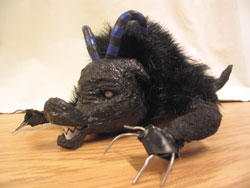Animating fur, foam and fabric on film

Students are encouraged to be creative when assembling their puppet/characters. This being was created by Jessie Trubiano for a project two years ago.
courtesy of Erik Goulet
You would be forgiven if you walked past the plaque designating the Puppet Animation Room at the Mel Hoppenheim School of Cinema and imagined Santa’s workshop with elves at benches gluing together little Pinocchios.
Actually, the room is used by Erik Goulet’s students to bring characters to life for his stop-motion animation course. The students devote the term to producing short films that explore the techniques made famous by companies like Aardman Animations, with their highly popular Wallace and Gromit characters.
Goulet shepherds his students through an intensive three-month course that involves learning how to fashion and manipulate characters that they must conceive and build entirely from scratch. “I pack 16 years of experience into three months. I give them everything I know,” Goulet said.
The labour-intensive course involves understanding that unlike traditional puppets with strings attached, these figures must have a completely articulated armature that can be repositioned over and over again to provide the filmed illusion that they are moving.
“Once students have the ‘bones’ — using either a metal frame or a ball/socket construction — they can drape it with anything from foam to plasticine. Everyone has their own style.”
Goulet recalled one student whose robotic puppet’s head was glue which had hardened with screws, bolts and LED lights poking out of it.
Goulet himself graduated from Concordia’s Department of Cinema in 1990 and began working in the industry. He continued to make his own stop-motion animation projects on the side. He learned that a stop-motion course was being offered here and was thrilled to hear that current students were able to take the course he had always wanted to take while he was doing his degree.
He dropped off a CV on the remote chance that the current instructor would be unable to teach, “It was a stroke of luck. He had an opportunity to work in Halifax and took it.” Goulet has been teaching the course each term ever since.
He said his own experience as a student helped him design the course (he only had two weeks to put together the curriculum that first year). “The class is very demanding and teaches you how to do everything — use electric tools, mold-making, sculpting, prop and set construction, animating, being a cameraperson, director of photography and animator.” Goulet uses his course to help students exploit all of those abilities in a single project.
Students present their puppets to each other at about this point in the term. Once students decide on their character, what it has to do, and where it will do it, all falls into place.
Goulet said that depending on the character and the idea, students may have a puppet walk into a room and sit down with a newspaper, dance around a set, or carefully articulate a single sentence synched with their mouth movements. The degree of complexity dictates the length of the final film, from 30 seconds up to two minutes.